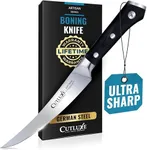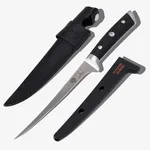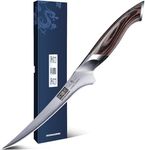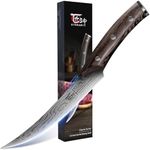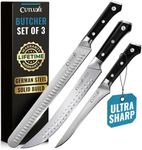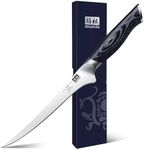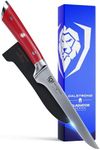Buying Guide for the Best Boning Knives
Choosing the right boning knife can make a significant difference in your kitchen experience, especially if you frequently prepare meat, poultry, or fish. A boning knife is specifically designed to remove bones from meat, and its unique features make it more efficient for this task compared to other types of knives. When selecting a boning knife, it's important to consider several key specifications to ensure you get the best fit for your needs. Here are the key specs to look out for and how to navigate them.Blade MaterialThe blade material of a boning knife is crucial as it affects the knife's sharpness, durability, and ease of maintenance. Common materials include stainless steel, high-carbon steel, and ceramic. Stainless steel is resistant to rust and easy to maintain, making it a good all-around choice. High-carbon steel is extremely sharp and holds its edge well but requires more maintenance to prevent rust. Ceramic blades are very sharp and lightweight but can be brittle and prone to chipping. Choose a material based on your willingness to maintain the knife and your preference for sharpness and durability.
Blade FlexibilityBlade flexibility refers to how much the blade can bend without breaking. This is important because a more flexible blade can navigate around bones and joints more easily, making it ideal for poultry and fish. Stiffer blades are better for tougher meats like beef and pork. If you primarily work with delicate meats, opt for a more flexible blade. For general use or tougher meats, a stiffer blade will provide better control and strength.
Blade LengthBoning knives typically range from 5 to 7 inches in length. The length of the blade affects how maneuverable the knife is and how much control you have. Shorter blades (around 5 inches) offer more precision and are easier to handle, making them suitable for smaller cuts of meat and intricate work. Longer blades (6-7 inches) are better for larger cuts and provide more leverage. Consider the types of meat you usually work with and choose a blade length that matches your needs.
Handle MaterialThe handle material affects the comfort, grip, and durability of the knife. Common handle materials include wood, plastic, and composite. Wooden handles offer a traditional feel and good grip but require more maintenance to prevent damage from moisture. Plastic handles are durable, easy to clean, and often have ergonomic designs for comfort. Composite handles combine the best of both worlds, offering durability and a good grip. Choose a handle material that feels comfortable in your hand and suits your maintenance preferences.
Blade ShapeThe shape of the blade can influence how well the knife performs specific tasks. Curved blades are excellent for making precise cuts and working around bones, while straight blades provide more power for cutting through tougher sections. If you need a knife for detailed work and maneuvering around bones, a curved blade is ideal. For more general use and cutting through larger sections of meat, a straight blade may be more suitable.
Weight and BalanceThe weight and balance of a boning knife affect how comfortable it is to use over extended periods. A well-balanced knife will feel comfortable and natural in your hand, reducing fatigue. Heavier knives can provide more cutting power, while lighter knives offer more control and precision. Consider your own strength and comfort preferences when choosing the weight and balance of your knife. Holding the knife in your hand before purchasing can help you determine if it feels right for you.



